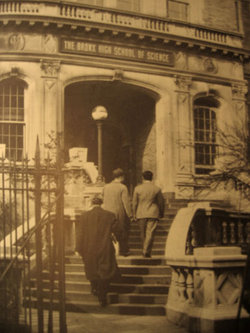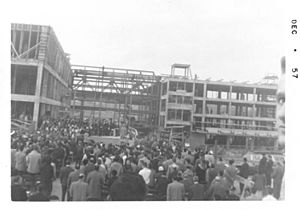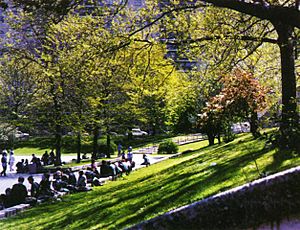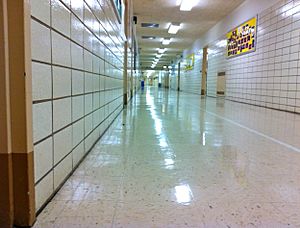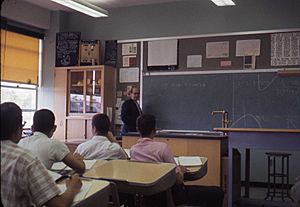Bronx High School of Science facts for kids
Quick facts for kids Bronx High School of Science |
|
|---|---|
 |
|
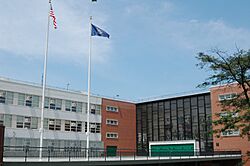
Bronx High School of Science in July 2006
|
|
| Address | |
|
75 W 205th St
, 10468
United States
|
|
| Coordinates | 40°52′42″N 73°53′27″W / 40.87833°N 73.89083°W |
| Information | |
| Type | Public, selective school |
| Motto | Inquire, Discover, Create |
| Established | 1938 |
| Founder | Morris Meister |
| School district | New York City Department of Education |
| School number | X445 |
| NCES School ID | 360008701922 |
| Principal | Rachel Hoyle |
| Teaching staff | 141.42 (on a FTE basis) |
| Grades | 9–12 |
| Enrollment | 2,951 (2022–2023) |
| Student to teacher ratio | 20.87 |
| Campus | City: Large |
| Color(s) | Green and gold |
| Athletics conference | PSAL |
| Mascot | Wolverines |
| Newspaper | The Science Survey |
| Yearbook | The Observatory |
| Affiliation | National Consortium of Secondary STEM Schools |
| Nobel laureates | 9 |
The Bronx High School of Science is a special public high school in the Bronx, New York City. It is run by the New York City Department of Education. To get into Bronx Science, students must pass a special entrance exam.
The school was started in 1938. It is located in a neighborhood called Kingsbridge Heights. While it is famous for mathematics and science, Bronx Science also teaches a lot about the humanities (like history and literature) and social sciences.
People often call it Bronx Science, Bronx Sci, or BX Sci. Sometimes, they just say Science. Its founder, Morris Meister, used to call it "The High School of Science."
Contents
History of Bronx Science
Bronx Science began in 1938. It was a special high school for boys who loved science and math. Dr. Morris Meister was its first principal. The school first used an old building on Creston Avenue and 184th Street. This building had been used by other schools before. Some teachers from Stuyvesant High School also joined the new school.
Dr. Meister helped shape the school from the start. He chose green and gold as the school colors. Green stood for chlorophyll, and gold for the sun. Both are important for life.
From the beginning, parents and Dr. Meister wanted a new building. The first building was too small for all the students. So, part of another school building was used as an "Annex." The school started with about 400 students. Over time, more boys joined Bronx Science.
In 1946, girls were also allowed to attend Bronx Science. This gave girls in New York City a chance to get a great education in science. Bronx Science became co-ed much earlier than other similar schools.
In 1958, Dr. Meister left his role as principal. He became the first president of Bronx Community College. He chose Dr. Alexander Taffel to be the next principal.
After 20 years, a new building was finally ready. It cost $8 million and was designed by Emery Roth and Sons. The new building was on 205th Street. It was near DeWitt Clinton High School and Lehman College. On March 3, 1959, students and teachers moved into the new building. They even helped move library books!
The new building had modern classrooms and labs. The main entrance had a huge mosaic mural. It showed famous scientists like Marie Curie and Charles Darwin. The mural also had a quote from John Dewey: "Every great advance in science has issued from a new audacity of imagination." This mural is called Humanities Protecting Biology, Physics, Chemistry.
When the school moved, there were rumors about groups of young people coming to the school. These rumors were not true. Another event happened that spring. When girls from Bronx Science first used the outdoor gym field, some boys from the nearby all-male DeWitt Clinton High School tried to get closer. The fence held, and the girls used indoor facilities for the rest of that year.
In June 1963, Bronx Science celebrated its 25th anniversary. President John F. Kennedy praised the school. He called it a great example of a program for gifted science and math students. Kennedy had recently chosen Harold Brown, a 1943 Bronx Science graduate, for an important role. Brown later became the United States Secretary of Defense.
What Students Learn (Academics)
Bronx Science students follow a curriculum that prepares them for college. They take four years of science, English, and social studies. They also take three or four years of math. Students take two or three years of a foreign language. A year of fine arts is also required.
The school offers many courses, including honors and advanced placement (AP) classes. AP classes can help students earn college credit early. There are over 100 different courses available. Most New York State Regents classes are offered.
In biology, Bronx Science has a special honors course. This course includes more lab work. If students took biology in middle school, they can take chemistry in their first year. All students must take at least one year of a biology lab science. They can choose from many advanced classes. These include AP Biology, AP Environmental Science, and AP Psychology. Other advanced courses are animal behavior, cell biology, and forensic science.
For physical sciences, students can take AP Chemistry and AP Physics. Electives include astronomy, electrical engineering, and organic chemistry. In 2022, the school prepared to get an astronomical observatory.
First-year students must take courses in research literacy and engineering. Second-year students take courses in coding and rhetoric. These are called Foundational courses. Second-year students can also join the research program. This three-year program ends with a big research project. Students can enter their projects in competitions like Regeneron. The research program has different areas like biology, math, and social science.
The math department offers standard AP courses. These include AB/BC calculus, statistics, and computer science. Students can take advanced math classes early. Post-AP courses include multivariable calculus and linear algebra. They also offer classes in video game development and app development. A new course in financial and actuarial math is also available.
Students must take four years of English. AP English Language and AP English Literature are offered. Other classes include journalism and yearbook design. In their third year, students can take AP American Studies. This class combines AP English Language and AP United States History. In their final year, AP English Literature is split into creative writing and traditional literature.
Four years of social studies or history classes are required. AP European History and AP World History are offered in the second year. Third-year students can take AP United States History. Senior social studies classes include U.S. Government and Politics and Microeconomics. Other social studies classes include AP Human Geography and race and gender.
Students need at least two years of a foreign language. Bronx Science offers French, Spanish, Latin, Italian, Chinese, and Japanese.
Students also need credits from two fine arts classes. This can be done during the Bronx Science Summer Program. They can take drama, music, or art. Students often take two courses in one summer to finish this requirement. They can also take art or music classes during the school year. Health and physical education courses are also required. The health requirement can also be met during the summer program.
Advanced Placement Courses
Bronx Science offers many AP courses. These help students get a head start on college.
- English – AP English Literature and Composition, AP English Language and Composition
- Social Sciences – AP U.S. History, AP European History, AP World History (2 Years), AP U.S. Government & Politics, AP Microeconomics, AP Macroeconomics, AP Human Geography, AP Psychology
- Mathematics – AP Calculus AB, AP Calculus BC, AP Statistics, AP Computer Science
- Science – AP Biology, AP Environmental Science, AP Chemistry, AP Physics 1&2, AP Physics C
- Language – AP Spanish Language, AP Spanish Literature, AP French Language and Culture, AP Italian Language and Culture, AP Latin, AP Chinese Language and Culture, AP Japanese Language and Culture
- Arts – AP Studio Art, AP Art History, AP Music Theory
School Publications
The Science Survey is the school's newspaper. Students do all the work, from writing to design. It is printed using money from ads. The paper is given out about five times a year for free. The Science Survey has been the newspaper's name since 1938.
Dynamo is a literary magazine. It features poems and stories written by students. The Observatory is Bronx Science's award-winning yearbook.
Vox Discipulorum is a monthly publication by students. It lets students share their language and cultural experiences. They can submit essays, poems, and artwork.
Other departments also create publications. The Math Bulletin has student papers and research. Exposition is from the Social Studies Department. Reactions is written by physical science students.
School's Reputation
Bronx Science is known around the world. In 2020, Newsweek ranked it as the 4th best STEM school in the United States. STEM stands for Science, Technology, Engineering, and Math.
In 2014, the school was ranked 34th among all high schools nationwide. It was also ranked 1st in New York. Bronx Science attracts smart students from all backgrounds in New York City. It is considered one of the top-performing schools in America.
The average SAT score at Bronx Science was 2100 out of 2400. Almost all graduates go on to four-year colleges. Many students go to top universities like Ivy League schools.
Bronx Science has had 132 finalists in the Regeneron Science Talent Search. This is the most of any high school. Nine graduates have won Nobel Prizes. This is more than any other high school in the world. Nine graduates have also won Pulitzer Prizes. Seven of the Nobel Prizes were in physics. Because of this, the American Physical Society named Bronx Science a "Historic Physics Site" in 2010.
Bronx Science is part of the National Consortium of Secondary STEM Schools. It is one of the three original specialized science high schools in New York City. The others are Stuyvesant High School and Brooklyn Technical High School.
Getting There (Transportation)
The New York City Subway has stations nearby. These are Bedford Park Boulevard (B D trains) and Bedford Park Boulevard–Lehman College (4 train). Also, New York City Bus routes Bx10, Bx22, Bx26 and Bx28 stop close to Bronx Science.
Famous Graduates (Notable Alumni)
Many people who went to Bronx Science have become very successful. They have won Nobel and Pulitzer Prizes. They have also won Academy, Emmy, and Turing Awards. Some have won the U.S. National Medal of Science. Others have held political office.
Bronx Science has produced the most Nobel laureates of any high school in the world. Its alumni have also won three Turing Awards. These are sometimes called the Nobel Prize for computer science. Six graduates have won National Medals of Science. This is the highest science honor in the nation. Nine have won Pulitzer Prizes for their work.



